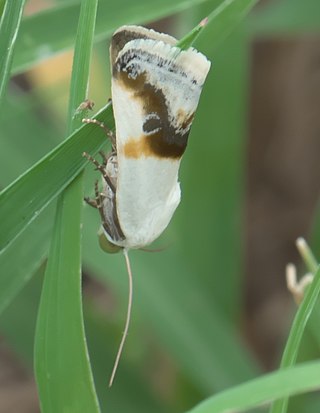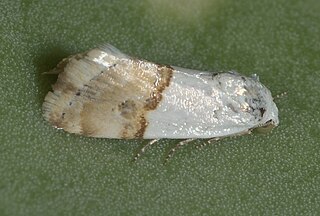
Ambrosia artemisiifolia, with the common names common ragweed, annual ragweed, and low ragweed, is a species of the genus Ambrosia native to regions of the Americas.

Ponometia is a genus of moths of the family Noctuidae. The genus was erected by Gottlieb August Wilhelm Herrich-Schäffer in 1868.

Ponometia semiflava, the half-yellow or yellow-cloaked midget, is a moth of the family Noctuidae. The species was first described by Achille Guenée in 1852. It is found in North America from New York and New England to Florida, west to Arizona, north to British Columbia and Manitoba.

Ponometia erastrioides, the small bird-dropping moth or small bird lime moth, is a moth of the family Noctuidae. It is found in North America, where it has been recorded from the eastern United States and south-central Canada. The habitat consists of fields, waste places and riparian areas.
Ponometia septuosa is a species of bird dropping moth in the family Noctuidae. It is found in North America.
Ponometia virginalis is a species of bird dropping moth in the family Noctuidae. It is found in North America, where it has been recorded from eastern Texas to Nebraska, west to eastern Arizona in the south, and to Utah, Colorado, and Wyoming in the west.
Ponometia alata is a species of bird dropping moth in the family Noctuidae.
Ponometia dorneri is a species of bird-dropping moth in the family Noctuidae. It was first described by William Barnes and James Halliday McDunnough in 1913 and it is found in North America.
Ponometia clausula is a species of bird dropping moth in the family Noctuidae.

Ponometia cuta is a bird dropping moth in the family Noctuidae. The species was first described by Smith in 1905.
Ponometia bicolorata is a species of bird-dropping moth in the family Noctuidae. It was first described by William Barnes and James Halliday McDunnough in 1912 and it is found in North America.
Ponometia heonyx is a species of bird dropping moth in the family Noctuidae.

Ponometia binocula, the prairie bird-dropping moth, is a bird dropping moth in the family Noctuidae. The species was first described by Augustus Radcliffe Grote in 1875.
Ponometia sutrix is a species of bird dropping moth in the family Noctuidae. It is found in North America.
Ponometia pulchra is a species of bird-dropping moth in the family Noctuidae. It was first described by William Barnes and James Halliday McDunnough in 1910 and it is found in North America.
Ponometia nigra is a species of bird dropping moth in the family Noctuidae. It is found in North America.

Ponometia venustula is a species of bird dropping moth in the family Noctuidae first described by Francis Walker in 1865.
Ponometia acutus is a species of bird dropping moth in the family Noctuidae.

Ponometia libedis is a bird dropping moth in the family Noctuidae. The species was first described by Smith in 1900.

Ponometia elegantula, the Arizona bird dropping moth, is a species of bird dropping moth in the family Noctuidae. The species was first described by Leon F. Harvey in 1876.







